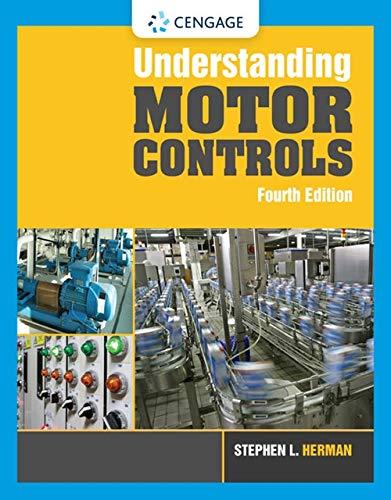
Understanding Motor Controls
4th Edition
ISBN: 9781337798686
Author: Stephen L. Herman
Publisher: Delmar Cengage Learning
expand_more
expand_more
format_list_bulleted
Textbook Question
Chapter 13, Problem 1RQ
What type of pressure switch is generally used to sense small changes in low pressure systems?
Expert Solution & Answer
To determine
The type of pressure switch that is generally used to sense small variations in low-pressure system.
Explanation of Solution
Pressure switches are the switches that operate with respect to pressure variation in a system. In general, the pressure system is classified into low-pressure system and high-pressure system. The low-pressure system uses a sensitive pressure switch. The diaphragm pressure switch is classified as a sensitive pressure switch. The diaphragm can respond to small pressures.
Thus, the type of pressure switch that is generally used to sense small variations in low-pressure system is a diaphragm pressure switch.
Want to see more full solutions like this?
Subscribe now to access step-by-step solutions to millions of textbook problems written by subject matter experts!
Students have asked these similar questions
please solve it with Pa and mm, thank you!
Can you help me by providing the solutions in MATLAB code?
Can you use MATLAB to help me solve part (d)
Chapter 13 Solutions
Understanding Motor Controls
Knowledge Booster
Learn more about
Need a deep-dive on the concept behind this application? Look no further. Learn more about this topic, mechanical-engineering and related others by exploring similar questions and additional content below.Similar questions
- Using a AutoCAD drawing the section view for the following multiview drawingarrow_forwardCan you help me by providing the MATLAB code?arrow_forwardThe figure illustrates the nonpermanent connection of a steel cylinder head to a grade 30 cast-iron pressure vessel using 73 bolts. A confined gasket seal has an effective sealing diameter D of 0.9 m. The cylinder pressure is cycled between a minimum pressure of zero and a maximum pressure p, of 535 kPa. For the specifications given in the table for the specific problem assigned, select a suitable bolt length from the preferred sizes. Use Table A-17 for calculation purposes. Parameter Head thickness, A Cylinder thickness, B Value 16 mm 25 mm Internal diameter of the cylinder, C 0.8 m Gasket sealing diameter, D Bolt circle diameter, E Outer diameter of the cylinder head, F 0.9 m 1.0 m 1.1 m Bolt grade ISO 10.9 Bolt diameter, d 10 mm F E D 111 Find a suitable bolt length. Then, determine the bolt stiffness, material stiffness and stiffness constant of the joint. The bolt length is The bolt stiffness is mm. MN/m. The material stiffness is | The stiffness constant is MN/m.arrow_forward
- Problem 3 A rotating shaft of 20 mm diameter is simply supported. The shaft is loaded with a transverse load of 10 kN as shown in the figure. The shaft is made from AISI 1095 hot-rolled steel. The surface has been machined. The shaft operate at temperature T = 450 °C. Consider a reliability factor of 95%. Determine (a) Calculate the reaction forces R₁ and R2* (b) Draw the shear force and bending moment diagrams and determine the maximum bending moment and shear force. 200 mm 20 mm 10,000 N -50 mm- C A B R₁ Not to scale. (c) Determine the critical location of the shaft and the maximum effective stresses, (d) Calculate the static safety factor against yielding. (e) Determined the endurance limit, adjusted as necessary with Marin factors. (f) Calculate the fatigue factor of safety based on achieving infinite life (g) If the fatigue factor of safety is less than 1, then estimate the life of the part in number of rotations, based on the ultimate strength of the material at T = 450 °C.arrow_forwardAn air duct heater consists of an aligned array of electrical heating elements in which the longitudinal and transverse pitches are SL = ST = 24 mm. There are 3 rows of elements in the flow direction (NL = 3) and 4 elements per row (NT = 4). Atmospheric air with an upstream velocity of 12 m/s and a temperature of 25°C moves in cross flow over the elements, which have a diameter of 12 mm, a length of 250 mm, and are maintained at a surface temperature of 350°C. (a) Determine the total rate of heat transfer to the air and the temperature of the air leaving the duct heater. (b) Determine the pressure drop across the element bank and the fan power requirement. (c) Compare the average convection coefficient obtained in your analysis with the value for an isolated (single) element. Explain the difference between the results. (d) What effect would increasing the longitudinal and transverse pitches to 30 mm have on the exit temperature of the air, the total heat rate, and the…arrow_forwardWhat is the elongation of the rod in inches? And what is the change in diameter? I dont want either answer rounded please! Thank you.arrow_forward
- Draw the shear and bending-moment diagrams for the beam and loading shown, and determine the maximum absolute value of (a) the shear, (b) the bending moment. 300 lb 240 lb 360 lb C D E A 4 in. 3 in. 4 in. 5 in. Fig. P12.5arrow_forwardA commercial office building is located in the city of Lansing, Michigan, and is heatedusing a gaseous fuel with a heating value of 725 Btu/std ft3. The indoor designtemperature is 71ºF. The heat load for the building is known to be 250,000 Btu/hr. Thisheat load accounts for the fact that there are internal heat gains in the building, due tothe presence of people and electronic equipment (e.g., lights and radios). People in thebuilding are usually seated and involved in light activity.a) The furnace had an initial efficiency factor of 73% when installed, but since thenefficiency-improvement retrofits were implemented that raised the efficiency factorto its present value of 82%. The building was designed using the 99% designheating temperature value for the city to determine the outdoor design temperature.Evaluate the annual fuel quantity (in std ft3) required to heat the building, using thedegree-day or bin method.b) Seventy people use the building, but the occupancy pattern for the…arrow_forwardThe volumetric flow rate of air through a duct transition of the type shown in Table 12-9b (rectangular with two parallel sides) is 2 m3/s. The duct before the transition issquare, with a height of 50 cm. The expansion ratio across the transition is 4 (i.e., theduct area after the transition is 4 times greater than the duct area before the transition).a) Determine the pressure loss (in Pa) across the transition if the exit from the duct isabrupt (i.e., the diverging angle of the transition is 180º).b) Determine the percentage reduction in pressure loss for a transition diverging angleof 20º compared to the one in part (a).c) The head HVAC engineer requires the pressure loss across the transition to bereduced to less than 50% of the pressure loss for an abrupt exit (i.e., the case in part(a)), and suggests a transition diverging angle of 45º. Will this new diverging angleachieve the required reduction in pressure loss? Justify your answer.d) For a transition diverging angle of 90º, the…arrow_forward
- The volumetric flow rate of air through a duct transition of the type shown in Table 12-9b (rectangular with two parallel sides) is 2 m3/s. The duct before the transition issquare, with a height of 50 cm. The expansion ratio across the transition is 4 (i.e., theduct area after the transition is 4 times greater than the duct area before the transition).a) Determine the pressure loss (in Pa) across the transition if the exit from the duct isabrupt (i.e., the diverging angle of the transition is 180º).b) Determine the percentage reduction in pressure loss for a transition diverging angleof 20º compared to the one in part (a).c) The head HVAC engineer requires the pressure loss across the transition to bereduced to less than 50% of the pressure loss for an abrupt exit (i.e., the case in part(a)), and suggests a transition diverging angle of 45º. Will this new diverging angleachieve the required reduction in pressure loss? Justify your answer.d) For a transition diverging angle of 90º, the…arrow_forwardAuto Controls The figure is a schematic diagram of an aircraft elevator control system. The input to the systemin the deflection angle of the control lever , and the output is the elevator angle phi.show that for each angle theta of the control lever ,there is a corresponding elevator angle phi. Then find Y(s)/theta(s) and simplify the resulting transfer function . Also note from the diagram that y and phi is related Show full solution, no copied solutionsarrow_forwardhand-written solutions only. correct answers upvotedarrow_forward
arrow_back_ios
SEE MORE QUESTIONS
arrow_forward_ios
Recommended textbooks for you
 Understanding Motor ControlsMechanical EngineeringISBN:9781337798686Author:Stephen L. HermanPublisher:Delmar Cengage Learning
Understanding Motor ControlsMechanical EngineeringISBN:9781337798686Author:Stephen L. HermanPublisher:Delmar Cengage Learning Refrigeration and Air Conditioning Technology (Mi...Mechanical EngineeringISBN:9781305578296Author:John Tomczyk, Eugene Silberstein, Bill Whitman, Bill JohnsonPublisher:Cengage Learning
Refrigeration and Air Conditioning Technology (Mi...Mechanical EngineeringISBN:9781305578296Author:John Tomczyk, Eugene Silberstein, Bill Whitman, Bill JohnsonPublisher:Cengage Learning Automotive TechnologyMechanical EngineeringISBN:9781337794213Author:ERJAVEC, Jack.Publisher:Cengage,
Automotive TechnologyMechanical EngineeringISBN:9781337794213Author:ERJAVEC, Jack.Publisher:Cengage, Automotive Technology: A Systems Approach (MindTa...Mechanical EngineeringISBN:9781133612315Author:Jack Erjavec, Rob ThompsonPublisher:Cengage Learning
Automotive Technology: A Systems Approach (MindTa...Mechanical EngineeringISBN:9781133612315Author:Jack Erjavec, Rob ThompsonPublisher:Cengage Learning Welding: Principles and Applications (MindTap Cou...Mechanical EngineeringISBN:9781305494695Author:Larry JeffusPublisher:Cengage Learning
Welding: Principles and Applications (MindTap Cou...Mechanical EngineeringISBN:9781305494695Author:Larry JeffusPublisher:Cengage Learning

Understanding Motor Controls
Mechanical Engineering
ISBN:9781337798686
Author:Stephen L. Herman
Publisher:Delmar Cengage Learning

Refrigeration and Air Conditioning Technology (Mi...
Mechanical Engineering
ISBN:9781305578296
Author:John Tomczyk, Eugene Silberstein, Bill Whitman, Bill Johnson
Publisher:Cengage Learning

Automotive Technology
Mechanical Engineering
ISBN:9781337794213
Author:ERJAVEC, Jack.
Publisher:Cengage,

Automotive Technology: A Systems Approach (MindTa...
Mechanical Engineering
ISBN:9781133612315
Author:Jack Erjavec, Rob Thompson
Publisher:Cengage Learning

Welding: Principles and Applications (MindTap Cou...
Mechanical Engineering
ISBN:9781305494695
Author:Larry Jeffus
Publisher:Cengage Learning
Mod-01 Lec-16 Basics of Instrumentation; Author: nptelhrd;https://www.youtube.com/watch?v=qbKnW42ZM5c;License: Standard YouTube License, CC-BY